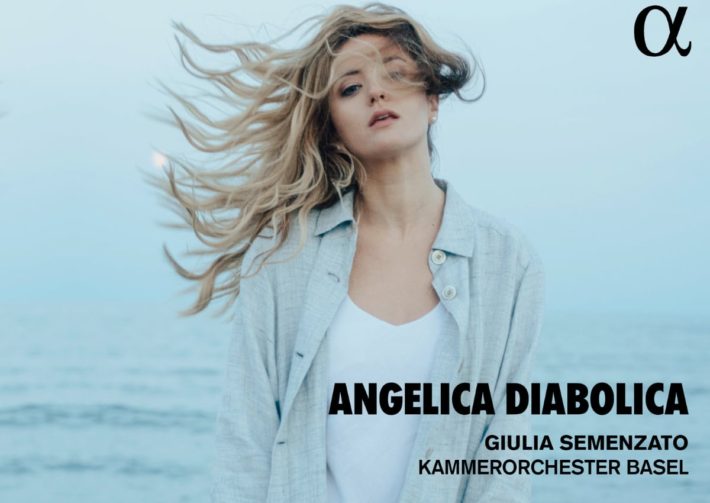Soprano Giuila Semenzato has carved herself out a successful niche in the genres of Baroque and Classical opera, including a recent Covent Garden debut (Mozart’s La Nozze di Figaro under Antonio Pappano) and a string of invitations and upcoming debuts in operas by Caldara, Monteverdi, and Handel. This first solo album with the Kammerochester Basel hones in on the Baroque era but finds its literary inspiration from slightly earlier–Ludovico Ariosto’s epic poem, Orlando Furioso.
According to the liner notes, Orlando Furioso keeps a focal perspective on the “male universe” but is not bereft of notable female characters including Angelica (a pagan princess) and Ginevra (princess of Scotland). The selections by Handel, Porpora, Sabadini et al. each provide a glimpse of these different heroines through different lenses.
In the excerpts from Luigi Rossi’s Il Palazzo Incantato, Angelica does not appear but another related female character, Marfisa, does. Si tocchi tamburo (track 1), is catchy with its infectious and rousing drumbeat. While Semenzato’s voice is definitely suited to the light Baroque textures, there could be more anchoring and definition against the resonant percussion (but perhaps this is a matter of sound engineering). Given that the song is essentially a call to war, more fire and sharpness is also needed to capture Marfisa’s vitality and spirit. What is undeniable, however, is the soprano’s finesse: the pitches of the melismatic passages are clearly defined but don’t sound labored. Bradamante (track 2) that follows is of a completely different flavor and a lovely one at that; the theorbo’s introduction is short but conveys an unmistakable sense of loneliness. I had expected the same airy quality in Semenzato’s voice from prior, but was pleasantly surprised by the supple, rich timbre and generous sostenuto in the phrases.
The selections by Nicola Porpora (tracks 3-4) capture two extreme moments for Angelica. In Mentre rendo a te la vita, she falls in love: the performance delivers a persistent urgency, but one that’s too uniformly present. The tempo is indeed on the pushy side and thus doesn’t allow the soloist’s nuances to materialize. A recording that scales back the pacing and to better results is Karina Gauvin’s (Atma, 2009). Here, we can better perceive details like the small but dramatic swells that convey the heroine’s yearnings. In Costante e fedele, Angelica escapes love: the ensemble’s energy is tangible and the singing technically faultless, more dimensionality is wanting to better distinguish it from the prior aria.
Related Posts
- Review: Handel – Enchantresses – Sandrine Piau
- Review: Sabine Devieilhe Sings Bach and Handel
- Review: Anima Aeterna – Jakub Józef Orlińsky, Countertenor
Both Carlo Francesco Pollarolo and George Frideric Handel use Ginevra as central subject matter in their respective Ariodante arias, but a comparison reveals interesting divergences. Pollarolo’s heroine (track 8) is a tragic figure who is condemned to death by none other than her father; the text describes Ginevra’s perception of a king who is also a father. The musical material speaks to this complicated relationship in its shifting tonalities and dynamics, and the performers effectively underscore the different moods. Semenzato’s timbre shifts are nuanced, but also reveal emotional sensitivities; this helps portray a woman who experiences sadness but in the face of dignity.
Handel’s version (track 9) places Ginevra in a far more happy light and the musicians emphasize this contrast to the Pollarolo. The soprano again has no difficulty navigating the demanding passages and manifests a vivacious yet elegant sense of joy. While the virtuosity of the aria can potentially render the ensemble redundant, this is not the case here: the parallels in phrases between the instrumentalists and soloist are maintained throughout so that the lines intertwine evenly and smoothly.
Among the other Handel selections, Mi restano le lagrime (track 10) is lovely. Semenzato captures the emotional tension especially in the intervallic leaps, which carry raw stabs of poignancy to convey Alcina’s despondency. The aria’s long lines require considerable breath control, which the singer provides throughout for seamless continuity.
The sound engineering proves a bit uneven across different arias, with the voice-ensemble equilibrium not always maintained. Giovanni Andrea Sechi’s liner notes, however, are good: well-organized, they provide the right amount of background into the poem itself and the settings of the songs. Listeners will also appreciate how the commentary aligns with the trajectory of the works. The insightful curation that balances Handel with some lesser-known composers also helps shape the album’s theme nicely. A few inconsistencies here and there may leave something to be desired, but this is nonetheless an enjoyable recording.

Angelica Diabolica
Giulia Semenzato – Soprano
Kammerorchester Basel
Alpha, CD 830
Related Albums
Read more classical music reviews or visit The Classic Review Amazon store
Follow Us and Comment:
Get our periodic classical music newsletter with our recent reviews, news and beginners guides.
We respect your privacy.









